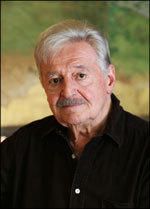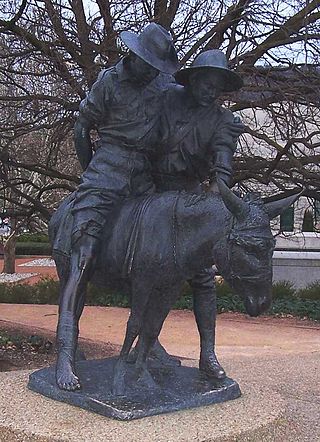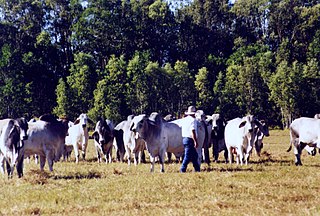
The didgeridoo is a wind instrument, played with vibrating lips to produce a continuous drone while using a special breathing technique called circular breathing. The didgeridoo was developed by Aboriginal peoples of northern Australia at least 1,000 years ago, and is now in use around the world, though still most strongly associated with Indigenous Australian music. In the Yolŋu languages of the indigenous people of northeast Arnhem Land the name for the instrument is the yiḏaki, or more recently by some, mandapul. In the Bininj Kunwok language of West Arnhem Land it is known as mako.

Anzac Day is a national day of remembrance in Australia and New Zealand that broadly commemorates all Australians and New Zealanders "who served and died in all wars, conflicts, and peacekeeping operations" and "the contribution and suffering of all those who have served". Observed on 25 April each year, Anzac Day was originally devised to honour the members of the Australian and New Zealand Army Corps (ANZAC) who served in the Gallipoli campaign, their first engagement in the First World War (1914–1918).

Australian cuisine is the food and cooking practices of Australia and its inhabitants. Australia has absorbed culinary contributions and adaptations from various cultures around the world, including British, European, Asian and Middle Eastern.

The culture of Australia is primarily a Western culture, originally derived from Britain but also influenced by the unique geography of Australia and the cultural input of Aboriginal, Torres Strait Islander and other Australian people. The British colonisation of Australia began in 1788, and waves of multi-ethnic migration followed. Evidence of a significant Anglo-Celtic heritage includes the predominance of the English language, the existence of a democratic system of government drawing upon the British traditions of Westminster government, parliamentarianism and constitutional monarchy, American constitutionalist and federalist traditions, and Christianity as the dominant religion.

Americana artifacts are related to the history, geography, folklore, and cultural heritage of the United States of America. Americana is any collection of materials and things concerning or characteristic of the United States or of the American people, and is representative or even stereotypical of American culture as a whole.

Peter Joshua Sculthorpe was an Australian composer. Much of his music resulted from an interest in the music of countries neighbouring Australia as well as from the impulse to bring together aspects of Aboriginal Australian music with that of the heritage of the West. He was known primarily for his orchestral and chamber music, such as Kakadu (1988) and Earth Cry (1986), which evoke the sounds and feeling of the Australian bushland and outback. He also wrote 18 string quartets, using unusual timbral effects, works for piano, and two operas. He stated that he wanted his music to make people feel better and happier for having listened to it. He typically avoided the dense, atonal techniques of many of his contemporary composers. His work was often characterised by its distinctive use of percussion. As one of the compositional pioneers of an distinctively Australian sound, Sculthorpe and his music have been likened to the role played by Aaron Copland in America's musical coming of age.

Kiwiana are certain items and icons from New Zealand's heritage, especially from around the middle of the 20th century, that are seen as representing iconic New Zealand elements. These "quirky things that contribute to a sense of nationhood" include both genuine cultural icons and kitsch.
A souvenir , memento, keepsake, or token of remembrance is an object a person acquires for the memories the owner associates with it. A souvenir can be any object that can be collected or purchased and transported home by the traveler as a memento of a visit. The object itself may have intrinsic value, or be a symbol of experience. Without the owner's input, the symbolic meaning is lost and cannot be articulated.

Australian literature is the written or literary work produced in the area or by the people of the Commonwealth of Australia and its preceding colonies. During its early Western history, Australia was a collection of British colonies; as such, its recognised literary tradition begins with and is linked to the broader tradition of English literature. However, the narrative art of Australian writers has, since 1788, introduced the character of a new continent into literature—exploring such themes as Aboriginality, mateship, egalitarianism, democracy, national identity, migration, Australia's unique location and geography, the complexities of urban living, and "the beauty and the terror" of life in the Australian bush.

The Anzac spirit or Anzac legend is a concept which suggests that Australian and New Zealand soldiers possess shared characteristics, specifically the qualities those soldiers allegedly exemplified on the battlefields of World War I. These perceived qualities include endurance, courage, ingenuity, good humour, larrikinism, and mateship. According to this concept, the soldiers are perceived to have been innocent and fit, stoical and laconic, irreverent in the face of authority, naturally egalitarian and disdainful of British class differences.

Kingswood Country is an Australian sitcom that was broadcast on the Seven Network from 1980 to 1984. It was created by Gary Reilly and Tony Sattler and produced by their production company, RS Productions. The series starred Ross Higgins, Judi Farr, Peter Fisher, Laurel McGowan and Lex Marinos, and was a spin-off from a series of sketches on the comedy sketch series The Naked Vicar Show.

In Australia, a stockman is a person who looks after the livestock on a station, traditionally on horse. It has a similar meaning to "cowboy". A stockman may also be employed at an abattoir, feedlot, on a livestock export ship, or with a stock and station agency.

Australian folklore refers to the folklore and urban legends that have evolved in Australia from Aboriginal Australian myths to colonial and contemporary folklore including people, places and events, that have played part in shaping the culture, image and traditions that are seen in contemporary Old Australia.

The Arts in Australia refers to the visual arts, literature, performing arts and music in the area of, on the subject of, or by the people of the Commonwealth of Australia and its preceding Indigenous and colonial societies. Indigenous Australian art, music and story telling attaches to a 40–60,000-year heritage and continues to affect the broader arts and culture of Australia. During its early western history, Australia was a collection of British colonies, therefore, its literary, visual and theatrical traditions began with strong links to the broader traditions of English and Irish literature, British art and English and Celtic music. However, the works of Australian artists – including Indigenous as well as Anglo-Celtic and multicultural migrant Australians – has, since 1788, introduced the character of a new continent to the global arts scene – exploring such themes as Aboriginality, Australian landscape, migrant and national identity, distance from other Western nations and proximity to Asia, the complexities of urban living and the "beauty and the terror" of life in the Australian bush.

The Anzac Day match is an annual Australian rules football match between Collingwood and Essendon, two clubs in the Australian Football League, held on Anzac Day at the Melbourne Cricket Ground (MCG).
The term "ocker" is used both as a noun and adjective for an Australian who speaks in Strine, a broad Australian accent, and acts in a rough and uncultivated manner. Richard Neville defined the ocker positively as being "about conviviality: comradeship with a touch of good-hearted sexism". However, the term is mostly understood to be pejorative compared to other terms, including larrikin, mate, cobber and bloke. In the 1980s, Carol Thatcher was said to have been met with a hostile reception when she attempted to write a book comparing "ockers" with "poms". John Richard wrote that the "awful ocker" juxtaposed with the "loveable larrikin".

Rhodesiana is any artifact, or collection of artifacts, which is related to the history, geography, folklore, and cultural heritage of Rhodesia, the name used before 1980 to refer to modern Zimbabwe. Many objects, both physical and immaterial, can be defined as "Rhodesiana"; a painting of a Rhodesian landscape, for example, could be considered as such, as well as a song by a Rhodesian artist or a tale or personality from the country's history. The things involved need not be old, but need to possess relevant associations with Rhodesia; for Rhodesian people and their descendants, a piece of Rhodesiana will commonly arouse feelings of patriotism and nostalgia.

The third attack on Anzac Cove was an engagement during the Gallipoli Campaign of the First World War. The attack was conducted by the forces of the Ottoman Turkish Empire, against the forces of the British Empire defending the cove.

Little Australia is a name for any of the various communities where Australians congregate upon emigrating to other countries. Examples can be found in the United States, Canada, and the United Kingdom. The concept of "Little Australia" holds many different aspects of the Australian culture. Common features include shops selling Australasian goods and restaurants lining the streets. A "Little Australia" strives essentially to have a sample of the culture of Australia transplanted to the midst of a large non-Australian city.

















